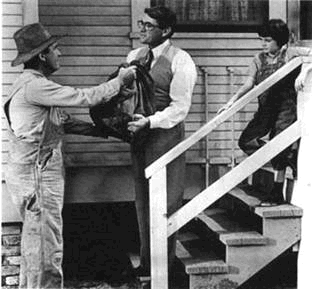TO KILL A MOCKINGBIRD: SEEING THE FILM THROUGH THE LENS OF MEDIA LITERACY
© 2006 Frank Baker
SETTING, PRODUCTION DESIGN & ART DIRECTION
Background on the Setting
 |
Representation: what do the clothes worn by Mr. Cunningham and Atticus communicate to us about the social status of the characters?
Notice too, how Atticus is strategically placed higher in the frame than Mr. Cunningham, again sending a message about status. Even Scout looks down on him. |
“The story takes places in a southern town in the 1930’s. Our first impression is that of a poor yet charming town in which people extend general courtesies to one another. An example (above) of this is seen when Mr. Cunningham pays Atticus for his legal work with chestnuts. Mr. Cunningham is embarrassed by his need to barter for the legal services, while Atticus attempts to reassure him of his gratitude.
Another important aspect to the setting is that we are introduced to the town through the eyes of children. And like the children, we see a seemingly simple society unraveling to reveal its darker side; while other previously held fears are proven wrong.
An analysis of the setting cannot be complete without mentioning the symbolic use of black and white film stock. To Kill A Mockingbird was produced in 1962. Color film had been used extensively prior to this production. Why would such an ambitious project not employ the latest technological advancements of the time? It seems that the use of black and white film stock had two purposes. First, it emphasizes the fact that the film took place in the past. Since this is actually a period piece, the film stock gives the picture an historical feel. Also, in 1962, the south was still dealing with serious forms of segregation. Perhaps the use of black and white allowed southern white viewers the luxury of examining racism in a historical and academic context. Second, the basic symbolic element of black and white film stock supports the racial viewpoints of the time that simplistically categorized the world into two camps consisting of black and white. In this backdrop we are introduced to Scout, Jem, and Atticus.” 8
Share This Page:


